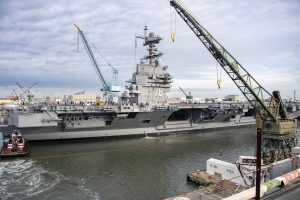The U.S. Navy is conducting a new panel to examine the future of the aircraft carrier and the kinds of aircraft that fly off it, with implications that the Navy is open to new naval aviation concepts and that its new class of supercarrier may be cut short in favor of new designs.
Acting Navy Secretary Thomas Modly announced the Future Carrier 2030 Task Force on Monday:
The long-term challenges facing our nation and the world demand clear-eyed assessments and hard choices. Because we have four new Ford carriers under contract, we have some time to reimagine what comes next. Any assessment we do must consider cost, survivability, and the critical national requirement to sustain an industrial base that can produce the ships we need—ships that will contribute to a superior, integrated naval force for the 2030s and far beyond.
According to the Navy, the study will explore the future role of aircraft carriers and the requirements that will best fit its missions to provide deterrence, global presence, protect the United States’ economic security, and engage in potential adversaries in combat. The study will consider various combinations of manned and unmanned aircraft options, as well as a mix of nuclear and conventionally-powered ships.
All of the U.S. Navy’s aircraft carriers are currently nuclear-powered. A 2017 think tank study ordered by Congress recommended adding smaller, conventionally-powered carriers to replace the Navy’s large amphibious ships and provide greater sea control and strike capacity to the fleet.
The study comes amid concerns about the cost of the Navy’s new carriers and the likelihood of tightening shipbuilding budgets in the coming decade, much of which is being taken up by the costs of replacing its fleet of aging ballistic missile submarines with the new Columbia-class.
The U.S. Navy currently operates 10 Nimitz-class aircraft carriers, which are being replaced by the Ford-class. Vessels in the new class utilize new electro-magnetic technologies to improve performance but have been delayed by technical problems. The U.S. Navy expects to retire half of its Nimitz-class carriers, built with 50-year service lives, by the mid-2030s, by which time the four remaining Ford-class hulls under contract will have been delivered. The cost of the new Ford-class carriers ballooned to nearly double what the Nimitz-class cost in inflation-adjusted dollars, though costs are expected to come down for the remaining four hulls under contract.
The USS Gerald R. Ford commissioned more than a year behind schedule in 2017 and was expected to complete its first deployment in 2020. It has since been plagued by ongoing, difficult-to-fix technical issues. Despite assurances from Navy officials it will beat current expectations, the ship still may not deploy for the first time until 2024, the year the first of the Nimitz-class carriers are scheduled to begin decommissioning. Meanwhile the second of the class, the future USS John F. Kennedy, was christened in December and is currently expected to be commissioned in 2022. If the technical problems that have delayed the Ford are not repeated on the Kennedy, they could end up deployable around the same time.
Facing both technical and budgetary pressures of its own, there are reports that China’s People’s Liberation Army Navy may slow its own acquisition of advanced new aircraft carrier designs, potentially halting construction with a fleet of four carriers — three indigenously-built hulls and the Liaoning, a re-furbished Soviet-built hull.

































